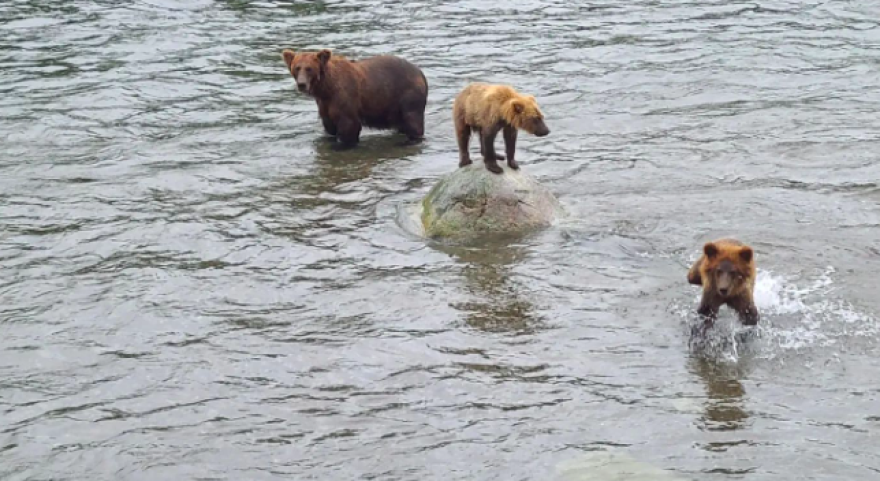Visitors arrive on the beach at Brooks Camp in Katmai National Park either by jet boat or float plane. Tourists pepper captains and park rangers with nervous questions before being ushered into the visitor center to watch an orientation video.
"The number one way of protecting bears and people is by properly managing your food…"
An eight-minute video prepares visitors for a one-of-a-kind park experience among bears feeding on healthy sockeye salmon runs along the Brooks River. All food items and gear are put in storage in Brooks Camp. Visitors walk along gated viewing platforms above the river. Below, bears roam or play or fish. At the famous Brooks Falls, bears stand and snatch leaping sockeye from the water.
One of the people on the platform is Saavik Ford. She her family are visiting from New York City. It’s their first time in Alaska — the 50th state they have visited together. They have been at Brooks Camp for five days.
“The first thing that you see when you go is just like, oh my god, bears! Bears everywhere, there are so many bears!" Ford said. "Then, when you get to go back over a course of a few days, you get to start to see who they are individually. You start to get to see their individual behaviors and their fishing strategies."

Glenn Curtis is an Anchorage-based pilot with a group at the Brooks Falls platform. He has taken day-trips to Brooks Falls for the last 47 years.
“There's nothing else like this in the world," he said. "I do guided tours here. I bring people from all over the world here. And there's nothing else like this that I know of anywhere in the world. And people send me Christmas cards six months from now, because they're still thinking about this.”

He said when he started coming in 1975, there was just a sheet of plywood on the bank of the river — no railing or other infrastructure.
“We didn't realize how risky it was, I guess. But we used to sit right over here and eat our lunch and watch the bears," Curtis said.
Brooks Camp, its park ranger program and its safety protocols were developed to keep both people and bears safe. That's become more important as tourism increases. And more people are coming to the camp, said Park Superintendent Mark Sturm.
“Here at Brooks Camp, we typically see lately, around 20,000 visitors, perhaps more during the season," said Sturm.

The park reduced capacity due to COVID concerns over the past two years, but this year it is fully open. Brooks Lodge is available through a lottery system, which opens in December and draws randomly for a stay of up to three nights. For $14 a night, people can also stay at the campground, surrounded by an electric fence.
Sturm said the crowds are challenging, but the park tries to manage them through measures like 30-minute time slots for the viewing platforms.
“It's not like it's the Grand Canyon where you have, you know, vistas in all kinds of different locations and you can spread people out," he said. "Everyone that comes here is essentially hoping to get to the falls, so it's a very condensed location everyone's trying to get to."
About 80 park staff and volunteers monitor walkways and platforms throughout the camp, making sure bears and people keep a healthy distance.
Sturm said the bears are used to having people around. But the park works to prevent any surprises, and keep the flow of people steady.
“We tend to let the bears behave naturally, and then try to manage the people movement around them," Sturm said.

Sturm doesn't know how the park can accommodate an increasing number of visitors each year; he said the park is planning to look at infrastructure improvements, and whether limits on crowds should be set — a process the park will likely start next year.
Harriet Cody and Harvey Satis traveled from Seattle, Washington, to celebrate their 50th wedding anniversary at Brooks Camp. They entered the lottery for a stay at Brooks Lodge in 2019, and were thrilled to get a spot this year.
“We've seen videos and photos and read about it. But there's never any comparison to being here in person," Cody said.
All along the river, bears are feeding on salmon to fatten up for the winter, when they will spend several months without food or water in hibernation. That process is now captured on the park’s popular live web cam, and thousands around the world cheer on fat bears during the park's annual Fat Bear Week.
Cody said seeing healthy salmon runs is awe-inspiring, especially coming from Washington state, where runs have severely diminished.
“What I personally hadn't even thought about was the magic and the magnificence of all the salmon activity — watching the salmon!” Cody said. "Where we come from in western Washington, one of our native salmon species is endangered, and our salmon are at risk. And to be here, in this environment, in this peak sockeye salmon year run, and see the interaction between the salmon and the bears. And this whole environment — the birds. We’re birders, and seeing the birds who are feeding off the leftovers of the bears.”
Her husband, Harvey Sadis added he enjoys watching the bears' fishing strategies, which include diving, snorkeling, or the ‘snatch-and-grab’ from atop Brooks Falls.
“Some of them doing belly flops, some of them getting into the top of the falls, waiting for fish to come through," Sadis said. "It's absolutely wonderful to see how these bears figure out their best fishing moment.”

Each year that the salmon run, and the bears return to fish and fatten up for winter, the park is trying to strike a delicate balance of how many enthusiastic visitors can also come to see them.
Get in touch with the author at news@kdlg.org or call (907) 842-2200.



